
10 conifers for a South-facing garden
The most suitable varieties
Contents
The majority of conifers require full sun exposure to thrive in the garden. Indeed, in the shade, they can become sparse. This quest for light is evident in nature, particularly in the forest. It is known that the search for light explains the conical shape of conifers in northern regions. In the garden, a south-facing position is the ideal location for conifers that do not fear heat and the blazing rays of the sun. Discover our selection of decorative conifers for south-facing gardens.
To avoid any failures, we recommend planting appropriately: feel free to use our web application Plantfit.
Provence Cypress or Florence Cypress - Cupressus sempervirens 'Totem'
The Florence cypress, Cupressus sempervirens ‘Totem’ is a large evergreen conifer celebrated for its unique columnar habit. It does not produce cones, allowing it to maintain its impeccable silhouette. It is hardy in well-drained soil and tolerates drought.

Elegance of the Provence cypress
Pair it with long-flowering, fragrant abelias such as Abelia chinensis, a Chinese Abelia capable of perfuming an entire garden in warm weather. It is a semi-evergreen shrub in mild climates, which takes on purplish to bronze hues in autumn. It has a natural charm. It blooms from summer to frost with a multitude of small pure white flowers with pink calyxes.
Leyland Cypress - Cupressocyparis leylandii 'Gold Rider'
The Cupressocyparis leylandii ‘Gold Rider’ is a variety of Leyland Cypress valued for its beautiful lemon yellow colour. Its fairly light yellow foliage withstands the sun well. When planted as a specimen, it stands out even by the seaside. Vigorous, it can reach 20 m in height if it grows freely.

Unusual beauty of the Leyland cypress ‘Gold Rider’ in lemon colour
Pair it with yellow flowering bushes such as:
- The Pineapple Broom Cytisus battandieri, which grows quickly. At its mature size, it reaches 3 to 4 m, with a spread of 2 to 3 m. Its flowers, ranging from lemon yellow to golden yellow, appear in May and smell of pineapple. It prefers light, well-drained soils, as winter moisture can harm its hardiness. This large bush will thrive in full sun, even in scorching conditions.
- Fremontodendron californicum has a spectacular golden yellow flowering until frost in mild climates. The decorative effect is enhanced when the sun reflects off its golden yellow petals. This evergreen shrub that requires well-drained soil without moisture is suitable for areas with cold, dry winters as it is hardy down to -12°C.
Discover other Conifers
View all →Available in 1 sizes
Available in 1 sizes
Available in 1 sizes
Available in 2 sizes
Available in 1 sizes
Available in 1 sizes
Available in 1 sizes
Available in 1 sizes
Available in 1 sizes
Available in 1 sizes
Lawson's cypress - Chamaecyparis lawsoniana ‘Elwoodii’
Chamaecyparis lawsoniana ‘Elwoodii’ is a beautiful variety of decorative conifer with an upright conical habit. Its evergreen foliage is a lovely bluish-green with greyish highlights. This narrow, compact conifer is ideal as a specimen or in a group in a medium to large garden. It thrives in sunny locations and prefers cool, fertile, deep, well-drained soil.
Pair it with ceanothus such as Ceanothus thyrsiflorus ‘Tuxedo’, notable for its shiny purple foliage that is almost black, which creates stunning contrasts with its sky-blue flower panicles in late spring. Tolerant of sea spray and drought, it performs beautifully in coastal gardens. Ceanothus ‘Edinburgh’ is a particularly large evergreen variety, offering deep blue flower bouquets from May to June. Ceanothus prefer warm, sunny locations, in rather dry, not overly rich, well-drained soil, without lime.
The umbrella pine - Pinus pinea
The Umbrella Pine Pinus pinea is well adapted to both drought and sea spray: perfect as a specimen by the seaside. It takes up little ground space but needs light to thrive.

Umbrella Pine has a very characteristic shape and beautiful colour
If your soil is acidic without hesitation, pair it with Azalea mollis ‘Persil’, a variety of Chinese azalea appreciated for its lovely spreading habit and its spring flowering, as bright as it is refined, featuring large flowers as beautiful as orchids. Little known and used, deciduous azaleas are very graceful non-calcareous soil plants. Otherwise, the Lonicera fragrantissima is for you; it is a bush honeysuckle that blooms in winter with a scent of lemon and jasmine. Its flowers are numerous from February. This vigorous winter honeysuckle is one of the essential shrubs in any sun-exposed garden.
Buddhist pine - Podocarpus macrophyllus
Podocarpus macrophyllus, or Buddhist pine, is an evergreen conifer. In our climates, it reaches 6 m in height and forms a perfect column with foliage resembling that of yew. It looks wonderful in a Japanese garden.
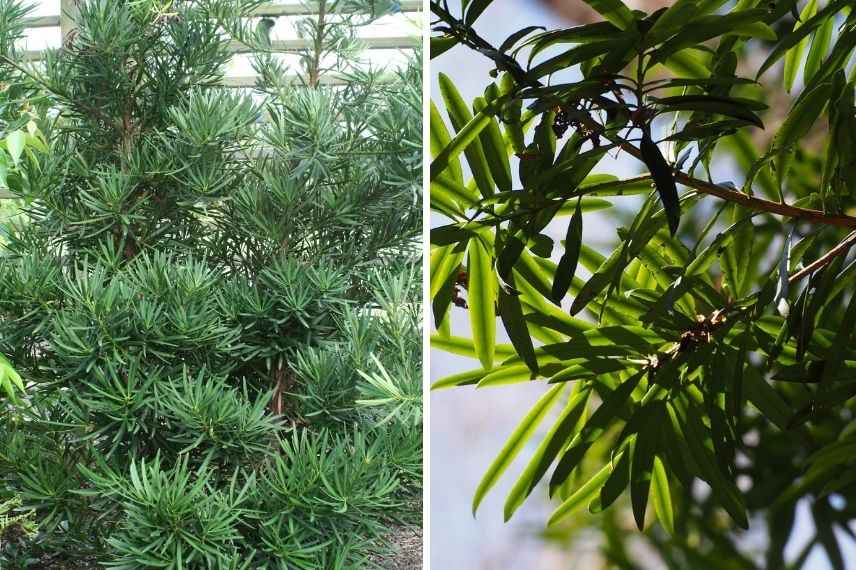
The yew-leaved podocarpus
Pair it with Nandina domestica for its changing foliage that transitions from red to green and finally to purple. Heavenly bamboo thrives in light, cool, well-drained soil. The Nandina domestica ‘Firepower’ prefers neutral to slightly acidic soils. The lanceolate leaves give it an airy appearance and resemble bamboo foliage. This resemblance has earned it the name heavenly bamboo or wonderful bamboo. The flowering consists of small white flowers in May-June, followed by small scarlet berries that are very decorative.
Atlas blue cedar - Cedrus libani 'Atlantica Glauca'
Cedrus libani ‘Atlantica Glauca’ stands out in the garden with light playing on its silvery foliage. With a rather slow growth rate in its early years, this robust conifer eventually becomes a tree of extraordinary aesthetics. Choose a very sunny and open location for it.
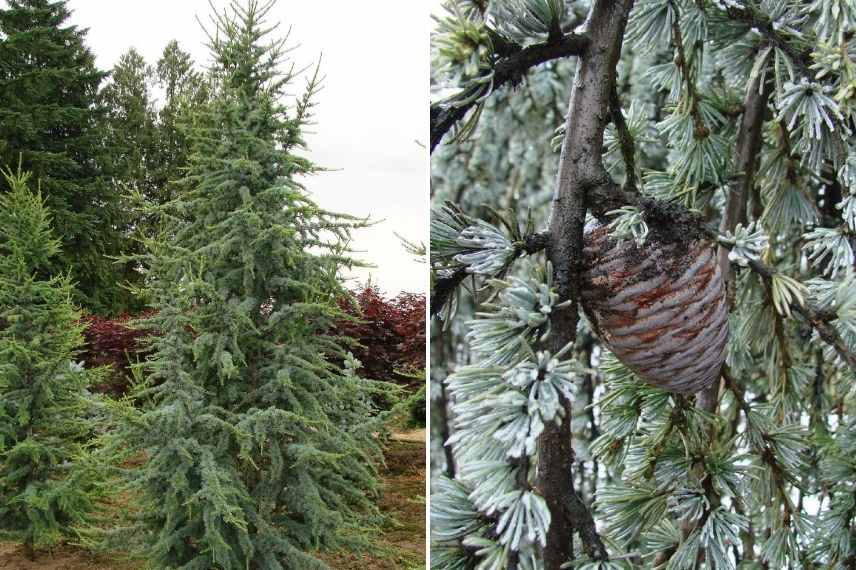
More resistant to the sun than the type, the Blue Cedar is very picturesque in the garden
Pair it with Malus ‘Prairiefire’, a flowering crab apple whose abundant flowering extends from spring to autumn with the presence of beautiful foliage and decorative fruits. This ornamental malus prefers fertile, cool, and deep soils. Plant it in the sun in well-drained soil, allowing it space to spread freely.
Scots pine - Pinus sylvestris
The Scots Pine Pinus sylvestriss, tall, sturdy, and very resilient, grows quickly in any well-drained soil. This large conifer, with its salmon-coloured scale-like bark and grey-blue foliage, charms with its picturesque habit. Its sparse crown will provide light, pleasantly fragrant shade in the garden. A perfectly hardy light-loving species, it withstands drought once established.
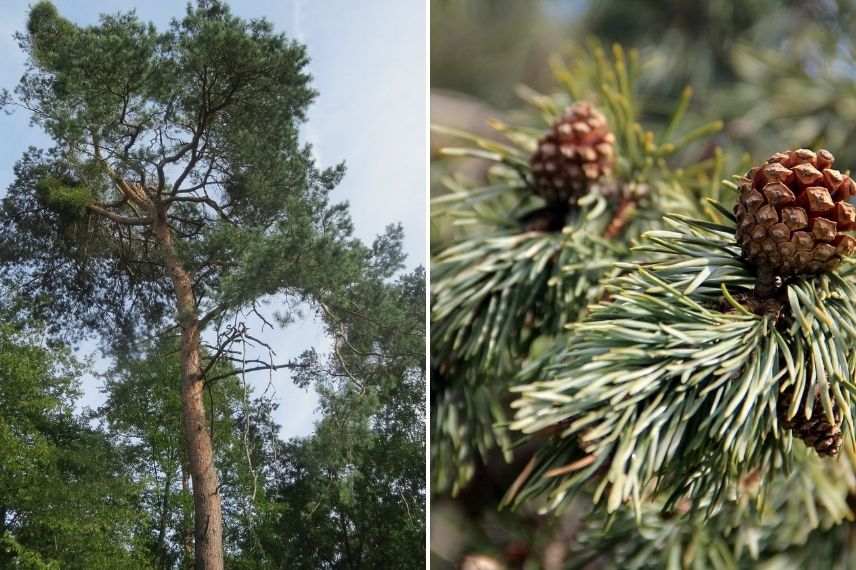 Scots Pine, ideal for large gardens
Scots Pine, ideal for large gardens
Pair it with the bright foliage of Gleditsia triacanthos ‘Sunburst’, the thornless Honey Locust. Its finely cut leaves transition from spring yellow to summer lime green, then turn to copper gold in autumn. Stunning as a specimen, this unique tree will adapt to any type of soil, and its good hardiness will allow it to acclimatise throughout France.
Maritime pine - Pinus pinaster
The maritime pine Pinus pinaster is a beautiful specimen to plant as a standalone. It thrives in warm, sunny locations and prefers deep, light soils. It also tolerates sea spray.

Elegance of the maritime pine
Pair it with the whitebeam or white rowan Sorbus aria, a small deciduous tree reaching 15 m in height and 8 m in spread. Its dark green leaves are glossy on top and silvery and downy underneath, giving the tree a shimmering appearance in the wind and sunlight. Flowering occurs in May-June, producing small white flowers, followed by orange-red fruits.
Virginia juniper - Juniperus scopulorum 'Blue Arrow'
Juniperus scopulorum ‘Blue Arrow’ is a medium-sized juniper that forms a narrow column. The bright blue-grey foliage of this beautiful conifer has real graphic qualities. It is unobtrusive and easily integrates into a mineral landscape or at the back of a large rockery.
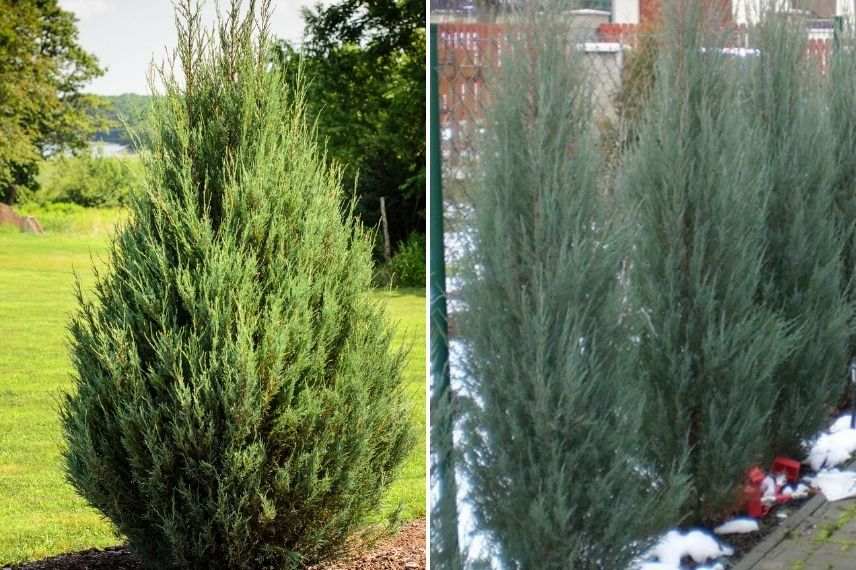
On the left, the Juniperus scopulorum; on the right, the cultivar ‘Skyrocket’
Indigofera heterantha is a pink indigo plant that grows quickly and easily reaches 1.5 m in all directions. It is content with ordinary soil, even poor and mediocre, as long as it is well-drained. It requires a warm, sunny exposure. This is an ornamental bush that is ideal for borders or rockeries. It is best to plant the Indigofera heterantha in a sheltered south-facing position and protect it from cold winds.
Colorado blue spruce - Picea pungens 'Iseli Foxtail'
Picea pungens ‘Iseli Foxtail’ is a medium-sized blue conifer that gradually forms a beautiful narrow and upright tree. It thrives in various climates, provided it has well-drained soil and sunny exposure. Its young spring shoots are an intense metallic blue. For the rest of the year, its colour is an intermediate shade between grey-green and blue-green. Its rough, scaly grey bark is quite decorative.
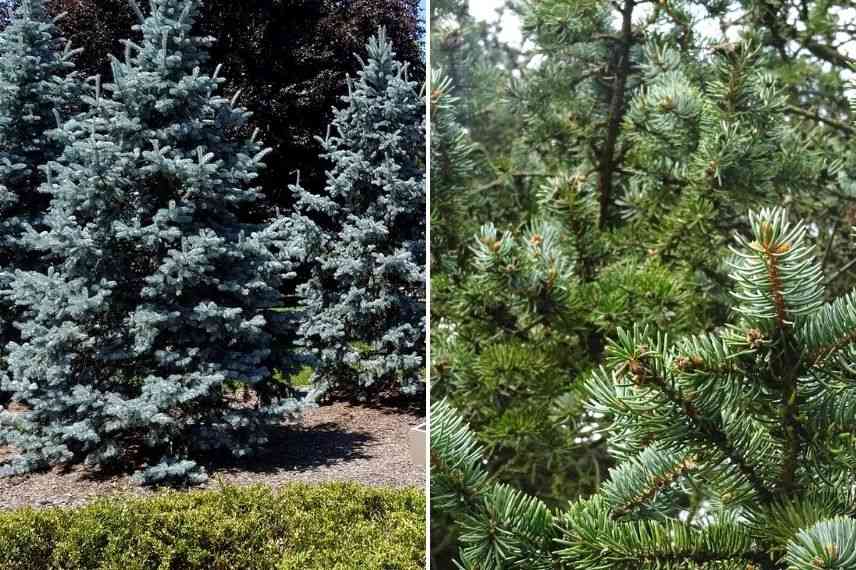
The Colorado spruce or blue spruce. On the right: detail of the cultivar ‘Iseli foxtail’
Pair it with a mix of asters and grasses. Aster laevis ‘Caliope’ is a large ornamental aster, unique with its black stems and purple foliage. In autumn, it produces a cloud of small mauve-blue stars with golden centres that turn purple. It requires full sun and soil that is not too heavy. This will create a refined wild-looking display well-suited to the blue spruce, along with Miscanthus sinensis ‘Little Miss’, which is remarkably colourful. This eulalia forms a clump of leaves tinged with red to purple in May, with colours intensifying in autumn due to the cold. Plume-like inflorescences appear in August-September, turning red in autumn and persisting on the plant until December.
- Subscribe!
- Contents
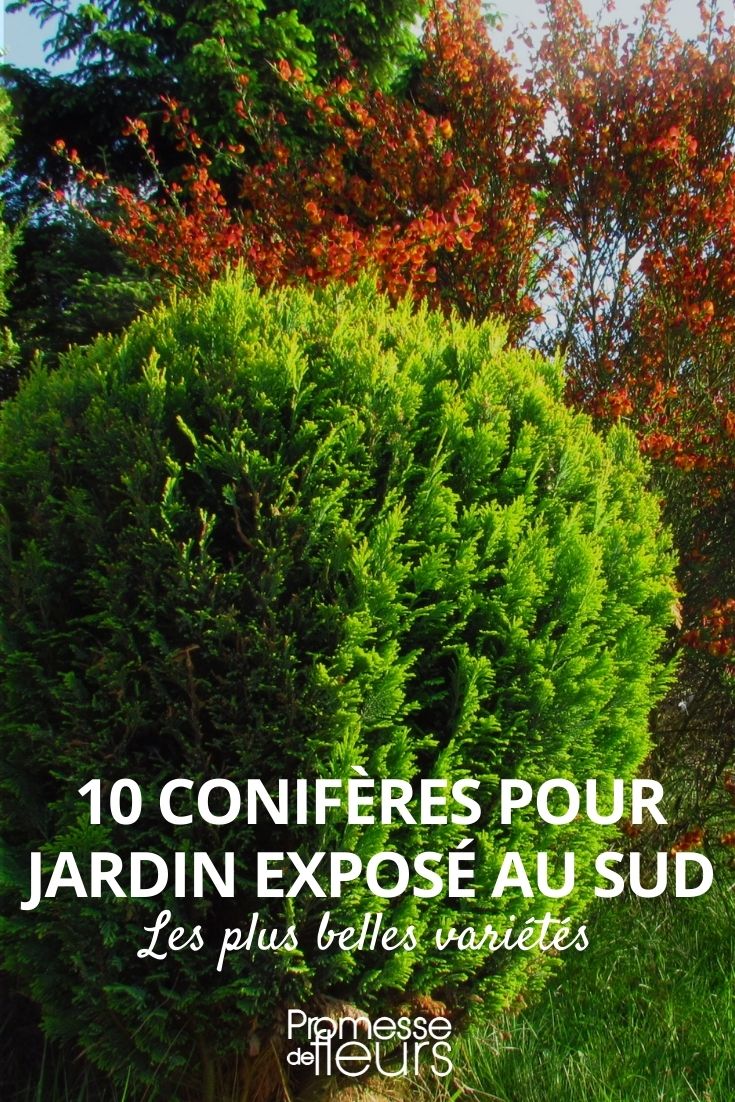
































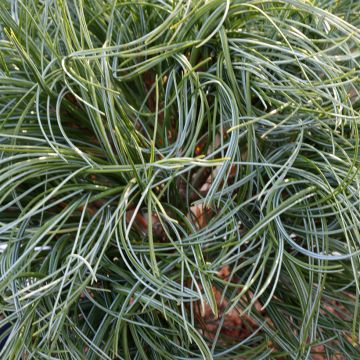
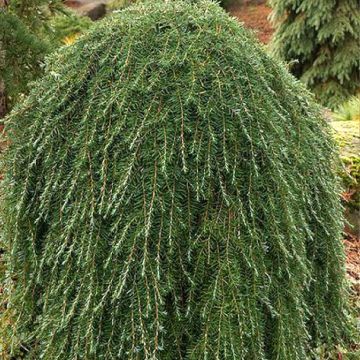


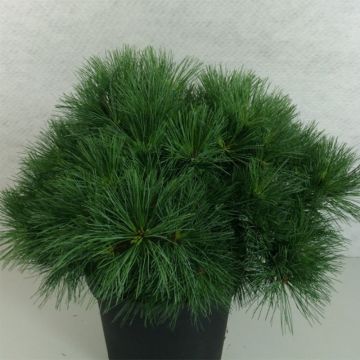

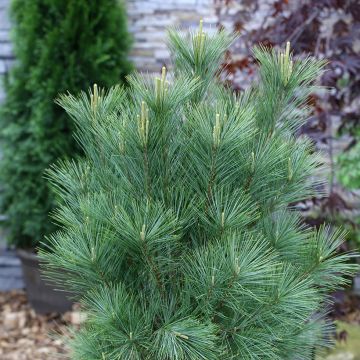

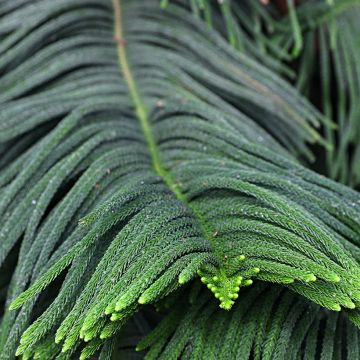
Comments